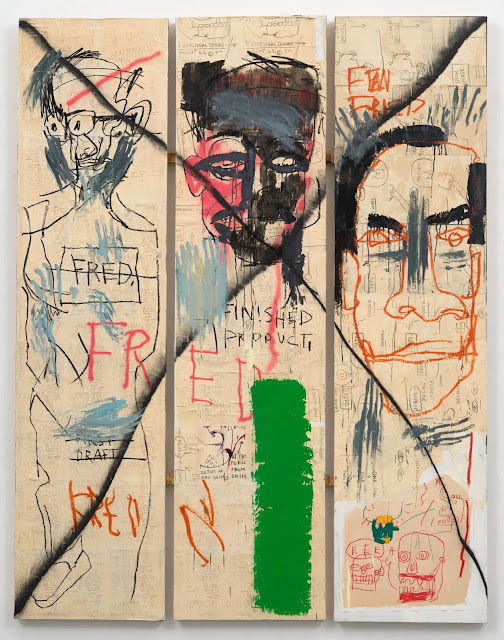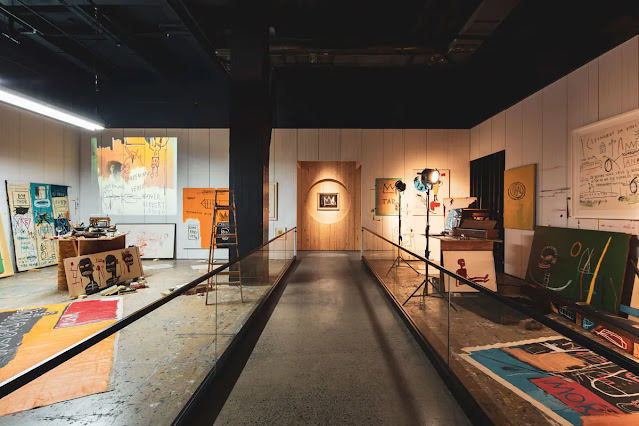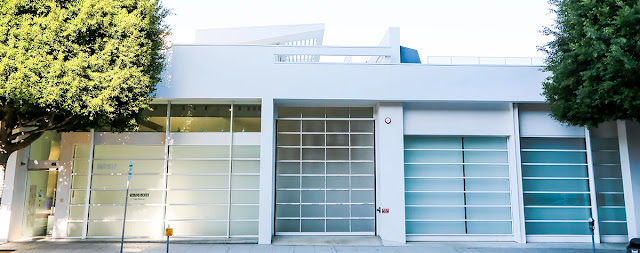JEAN MICHEL BASQUIAT AT GAGOSIAN BEVERLY HILLS …
Made on Market Street | Curated by Fred Hoffman with Larry Gagosian
March 7, 2024 – June 8, 2024
JEAN MICHEL BASQUIAT AT GAGOSIAN BEVERLY HILLS …
Made on Market Street | Curated by Fred Hoffman with Larry Gagosian
March 7, 2024 – June 8, 2024
Gagosian is pleased to announce Made on Market Street, the first exhibition focused exclusively on works that Jean-Michel Basquiat produced in Los Angeles. Curated by Fred Hoffman with Larry Gagosian, the exhibition will be on view from March 7 to June 1, 2024. With exhibition design by Stefan Beckman, Made on Market Street features loans from the Estate of Jean-Michel Basquiat; Nicola Erni Collection, Steinhausen, Switzerland; the Broad Art Foundation, Los Angeles; Museum Brandhorst, Munich; Museum of Modern Art, New York; Whitney Museum of American Art, New York; and other public and private collections. Between November 1982 and May 1984, Basquiat produced approximately a hundred paintings, numerous works on paper, and six silkscreen editions in Venice, California. For an artist closely Gagosian to Present the First Exhibition to Focus Exclusively on Jean-Michel Basquiat’s Time in Los Angeles Reuniting Nearly Thirty Works Produced near Venice Beach between 1982 and 1984 Curated by Fred Hoffman with Larry Gagosian, Made on Market Street Opens in Beverly Hills on March 7, 2024 Jean-Michel Basquiat, Hollywood Africans, 1983, acrylic and oil stick on canvas, 84 1/8 × 84 inches (213.5 × 213.4 cm), Whitney Museum of American Art, New York © The Estate of Jean-Michel Basquiat. Licensed by Artestar, New York. Photo: © Whitney Museum of American Art/Licensed by Scala/Art Resource, New York Download Press Images affiliated with the New York art scene of the 1980s, Basquiat was extraordinarily prolific in Los Angeles. Made on Market Street reflects on this consequential era by bringing together nearly thirty works—several of which are among his most important paintings. Larry Gagosian notes, “Los Angeles has always been a great city for artists and Jean-Michel seemed to find it a refreshing change from New York. While the immensity of his talent was immediately apparent, it was nonetheless a highlight of my own career to work with him, to introduce him to Los Angeles, and to witness the amazing impact that his art and legacy have made on our culture.” After first meeting Basquiat in 1981, Gagosian invited him to Los Angeles. Basquiat’s solo exhibition with Larry Gagosian Gallery in LA—the first time his work was presented on the West Coast—opened in April 1982, immediately following his first solo show in New York at Annina Nosei’s gallery. The Los Angeles exhibition was seen as the arrival of a significant voice by the public and collectors alike. In November 1982 Basquiat returned to California, living and working at Gagosian’s residence on Market Street, a three-story structure with an interior courtyard open to the light and air from the beach nearby. That same year, Basquiat met Fred Hoffman, who was running New City Editions, and together they would produce six editioned prints, including Tuxedo (1982) and Untitled (1983), large-scale silkscreen works on canvas. Featuring white text, sketches, and directional arrows on a black ground, Tuxedo contrasts with Basquiat’s intensely colorful paintings of the era, its dense collection of allusive phrases ascending to the crown at its top. For Basquiat, working in Venice offered a reprieve from the distractions and pressures of the New York art scene. Many of the paintings he produced in Venice were shown at his next Los Angeles exhibition, which opened on March 8, 1983, at Larry Gagosian Gallery and presented approximately thirty paintings, including Hollywood Africans, Horn Players, Museum Security (Hollywood Meltdown), Luna Park, Untitled, and Year of the Boar (all 1983). Made on Market Street will present many of these pivotal works together again for the first time. A highlight of the exhibition is Hollywood Africans, a work that portrays Basquiat alongside fellow artists Toxic and Rammellzee as new Black celebrities in a palette that evokes the bright Southern California sun. Fusing drawing, painting, and text across three panels, Horn Players pays homage to jazz greats Charlie Parker and Dizzy Gillespie. Underscoring the importance of music to Basquiat, it conveys the vitality of bebop in a visual style informed by contemporary graffiti and hip-hop. The same year it was painted, Basquiat would produce the influential hip-hop track “Beat Bop” on his own Tartown Record label, featuring Rammellzee and K-Rob. In the summer of 1983, Basquiat was drawn back to Los Angeles. He returned to Market Street, this time establishing his own studio a few doors down and remaining there until late in the spring of 1984. One night, while Basquiat was working, he went outside to a fenced-in courtyard just behind the studio, where he encountered an unhoused person sleeping. After this incident the courtyard’s fence was removed, but instead of disposing of the wooden slats Basquiat integrated them as supports for some of his most iconic paintings—Flexible, Gold Griot, and M (all 1984), all of which will be exhibited as a group in Made on Market Street for the first time since they were created. With Flexible, Basquiat expanded his portrayal of the Black male, presenting a larger-than-life figure whose elastic, expressive arm gesture combines the artist’s interests in anatomy, symbolism, and qualities he characterized as “royalty, heroism, and the streets.” Made on Market Street is accompanied by a catalogue that reproduces the exhibited works together with archival material, including installation images from the 1982 and 1983 exhibitions at Larry Gagosian Gallery, historical ephemera, and exhibition reviews, as well as previously unpublished photographs of Basquiat in his studio. A conversation between Larry Gagosian, Fred Hoffman, filmmaker Tamra Davis, and the artist’s sisters, Lisane Basquiat and Jeanine Heriveaux, will be featured, along with an essay where Hoffman reflects on the works that Basquiat produced in Los Angeles, discussing the complex symbolism and restless innovation that permeated his oeuvre. Larry Gagosian Gallery in Los Angeles presented three exhibitions with Basquiat during the artist’s lifetime: Jean-Michel Basquiat: Paintings at 619 North Almont Drive, April 8–May 8, 1982; Jean-Michel Basquiat: New Paintings at 510 North Robertson Boulevard, March 8–April 2, 1983; and Jean-Michel Basquiat at 510 North Robertson Boulevard, January 7–February 8, 1986. Made on Market Street is the seventh exhibition of Basquiat’s work that Gagosian has presented since the artist’s passing in 1988.
https://gagosian.com/exhibitions/2024/jean-michel-basquiat-made-on-market-street-curated-by-fred-hoffman-with-larry-gagosian/
“FRED,” 1983
Basquiat’s portrait of Hoffman.Credit...Estate of Jean-Michel Basquiat/
Licensed by Artestar, New
York
“FRED,” 1983 (DETAIL)
UNTITLED, 1983
Material3 parts; acrylic and oilstick on canvas
Dimensions: 243.8 x 62 cm
© Estate of
Jean-Michel Basquiat. Licensed by Artestar, New York
HORN PLAYERS, 1983
Acrylic and
oil stick on canvas mounted on wood supports, in 3 parts
Dimensions: Overall:
96 x 75 inches (243.8 x 190.5 cm)
The Broad Art Foundation
© Estate of
Jean-Michel Basquiat. Licensed by Artestar, New York
Photo: Rob
McKeever, Courtesy Gagosian
PINK PARKER,
1983
© Estate of
Jean-Michel Basquiat. Licensed by Artestar, New York
GOLD GRIOT, 1984
Acrylic and
Oilstick on Wood
Dimensions: 117
x 73 in. (297.18 x 185.42 cm)
© 2024 Estate of Jean-Michel Basquiat. Licensed by Artestar, New York.
FLEXIBLE, 1984
Acrylic and
oil stick on wood
Dimensions: 102
x 75 inches (259.1 x 190.5 cm)
Private collection, Beverly Hills, California
© Estate of
Jean-Michel Basquiat. Licensed by Artestar, New York
Photo: Jeff
McLane, Courtesy Gagosian
ABOUT THE GAGOSIAN
GALLERY
Established by Larry
Gagosian in Los Angeles in 1980, Gagosian is a global gallery specializing in
modern and contemporary art that employs more than three hundred people at nineteen
exhibition spaces across the United States, Europe, and Asia. In addition to
its galleries, Gagosian is at the forefront of the digital marketplace with
innovative online viewing rooms, timed to coincide with major art fairs, that
include highly desirable works by today’s leading artists, transparent pricing,
historical scholarship, and insightful market analysis.
Gagosian works with a
diverse array of marquee living artists, including Georg Baselitz, John Currin,
Rachel Feinstein, Urs Fischer, Ellen Gallagher, Theaster Gates, Katharina
Grosse, Mark Grotjahn, Jennifer Guidi, Andreas Gursky, Hao Liang, Michael
Heizer, Damien Hirst, Jia Aili, Y.Z. Kami, Titus Kaphar, Anselm Kiefer, Rick
Lowe, Vera Lutter, Sally Mann, Brice Marden, Takashi Murakami, Albert Oehlen,
Giuseppe Penone, Richard Prince, Nathaniel Mary Quinn, Nancy Rubins, Ed Ruscha,
Jenny Saville, Richard Serra, Taryn Simon, Rudolf Stingel, Sarah Sze, Adriana
Varejão, Jeff Wall, Mary Weatherford, Rachel Whiteread, and Jonas Wood, as well
as masters of design Frank Gehry and Marc Newson.
From its inception,
Gagosian has prepared and presented unparalleled museum-quality exhibitions of
works by historical artists such as Arakawa, Diane Arbus, Richard Artschwager,
Francis Bacon, Louise Bourgeois, Alexander Calder, Willem de Kooning, Walter De
Maria, Lucio Fontana, Helen Frankenthaler, Alberto Giacometti, Howard Hodgkin,
Roy Lichtenstein, Man Ray, Piero Manzoni, Agnes Martin, Claude Monet, Henry
Moore, Jackson Pollock, Cy Twombly, Andy Warhol, Tom Wesselmann, and Zao
Wou-Ki, among others. The gallery’s groundbreaking Picasso exhibitions, curated
by scholar John Richardson in New York and London, were attended by hundreds of
thousands of visitors. In 2019, Larry Gagosian curated an exhibition featuring
Picasso masterpieces as a tribute to Richardson following his death.
Gagosian began publishing
in 1986, becoming the first gallery to establish a publishing house that
produces a vast range of catalogues raisonnés, monographs, artist’s books,
scholarly exhibition catalogues, and limited editions. Today the gallery has
published more than six hundred titles, rivaling the output of traditional arts
trade publishers. The print and online editions of the Gagosian
Quarterly provide unique access to artists in their studios and homes
through insightful interviews and profiles of and by leading art world
professionals. With locations in New York and London, the Gagosian Shop curates
a coveted selection of rare books, art editions, unique collaborations, posters,
jewelry, apparel, and Leica cameras.
Gagosian has long
developed cultural programming and events with artists, including performances,
exhibition tours, public talks, film screenings, and studio visits. The gallery
has long been committed to working with and advising artists on all aspects of
their legacy planning. In 2018 the gallery launched its Building a Legacy
program, bringing together artists and their studio staff with experts in the
field of artists’ estates, nonprofit foundations, and legacy stewardship
through a series of symposia.
With exhibition spaces
designed by world-renowned architects such as Caruso St John, Richard Gluckman,
Richard Meier, Jean Nouvel, Selldorf Architects, and WHY, Gagosian is able to
show a wide range of compelling projects—including work as varied as Jenny
Saville’s painterly depictions of the human form, Richard Serra’s iconic
monumental sculptures and drawings, and a re-creation of Roy Lichtenstein’s
site-specific and temporary wall painting Greene Street Mural.
https://gagosian.com/about/about-gallery/
‘’ When I reflect back on
this time, I think of how it was the ideal moment for Jean-Michel to make his
mark in Los Angeles. I made introduction across the city from filmmakers to
musicians and offered the space and resources for him to create, but it was Jean-Michel
who made something spectacular from all of these connections. He sooked up the
opportunities to explore and experiment. It was an exciting time for both of
us. I could see it then. Today his mark is one of the most widely recognized
and celebrated in the world.’’
Larry Gagosian
HOLLYWOOD AFRICANS, 1983
Acrylic and
oil stick on canvas
Dimensions: 84
1/8 x 84 inches (213.5 x 213.4 cm)
Whitney Museum of American Art, New York; gift of Douglas S. Cramer
© Estate of
Jean-Michel Basquiat. Licensed by Artestar, New York
Photo: ©
Whitney Museum of American Art/Licensed by Scala/Art Resource, NY
Courtesy
Gagosian
MUSEUM SECURITY (BROADWAY MELTDOWN), 1983
Acrylic, oil
stick, and paper collage on canvas
Dimensions: 83
3/4 × 83 3/4 inches (212.7 × 212.7 cm)
Private collection
© Estate of
Jean-Michel Basquiat. Licensed by Artestar, New York
Courtesy
Gagosian
THE COVER OF ‘’BEAT BOP’’, 1983
© Estate of
Jean-Michel Basquiat. Licensed by Artestar, New York
YEAR OF THE
BOAR, 1983–1983
Acrylic on
Canvas
Dimensions: 190
x 244 cm. (74.8 x 96.1 in.)
© Estate of
Jean-Michel Basquiat. Licensed by Artestar, New York
TUXEDO, 1982
Silkscreen on
canvas
Dimensions: 102
1/4 x 60 inches (260 x 152.4 cm)
Edition of 10
Private collection, Los Angeles
© Estate of
Jean-Michel Basquiat. Licensed by Artestar, New York
Photo:
Fredrik Nilsen Studio, Courtesy Gagosian
UNTITLED 1983
Screenprint
on Canvas
Dimensions
Dimensions: composition
and overall: 57 5/8 x 75 9/16" (146.4 x 192 cm)
© 2024 Estate of Jean-Michel Basquiat. Licensed by Artestar, New York.
JEAN MICHEL BASQUIAT
Jean-Michel Basquiat was
born in 1960 in New York City, where he died in 1988. Born to a Haitian father
and a Puerto-Rican mother, Basquiat left his family home in Brooklyn, New York
at the age of fifteen and took to the streets. A voracious autodidact, he
quickly became a denizen of the explosive and decadent New York underground
scene—a noise musician who loved jazz, and a street poet who scrawled his
sophisticated aphorisms in Magic Marker across the walls of downtown Manhattan,
copyrighting them under the name SAMO. In 1981, he killed off this alter ego
and began painting and drawing, first on salvaged materials then later on
canvas and paper, and making bricolage with materials scavenged from the urban
environment. From the outset he worked compulsively; his passion for words and
music, his intense yet fluid energy, and the heterogeneous materials that he
employed so freely imbued his work with urgency and excitement. He sold his
first painting in 1981, and by 1982, spurred by the Neo-Expressionist art boom,
his work was in great demand. In 1985, he was featured on the cover of The New York Times Magazine in connection with an
article on the newly exuberant international art market. In that photograph,
Basquiat is a vision of cool, sprawled in a chair in an elegant three-piece
suit and tie, with bunched dreadlocks and bare feet, in front of a large, bold
painting—a supernova in the making.
Charismatic image aside,
Basquiat was a prodigious young talent, fusing drawing and painting with
history and poetry to produce an unprecedented artistic language and content
that bridged cultures and enunciated alternative histories. Combining materials
and techniques with uninhibited yet knowing and precise intent, his paintings
maintain a powerful tension between opposing aesthetic forces—expression and
knowledge, control and spontaneity, savagery and wit, urbanity and
primitivism—while providing acerbic commentary on the harsh realities of race,
culture, and society.
Basquiat is represented
in several prominent museum collections all over the world. Major solo
exhibitions include “Jean-Michel Basquiat: Paintings 1981–1984,” Fruitmarket
Gallery, Edinburgh (1984; traveled to the Institute of Contemporary Arts,
London; and the Museum Boijmans Van Beuningen, Rotterdam, through 1985);
Whitney Museum of American Art, New York (1992; traveled to the Menil
Collection, Houston; the Des Moines Art Center, Iowa; and the Montgomery Museum
of Fine Art, Alabama, through 1994); “Basquiat,” Brooklyn Museum of Art, New
York (2005; traveled to the Museum of Contemporary Art, Los Angeles; and the
Museum of Fine Arts, Houston, through 2006); Fondation Beyeler, Basel,
Switzerland (2010; traveled to Musée d’art Moderne de la Ville de Paris); and
“Basquiat: The Unknown Notebooks,” Brooklyn Museum, New York (2015). Basquiat
starred in “Downtown 81,” a verité movie that was written by Glenn O’Brien,
shot by Edo Bertoglio, and produced by Maripol in 1981, but not released until
2000.
https://gagosian.com/artists/jean-michel-basquiat/












































































































.png)